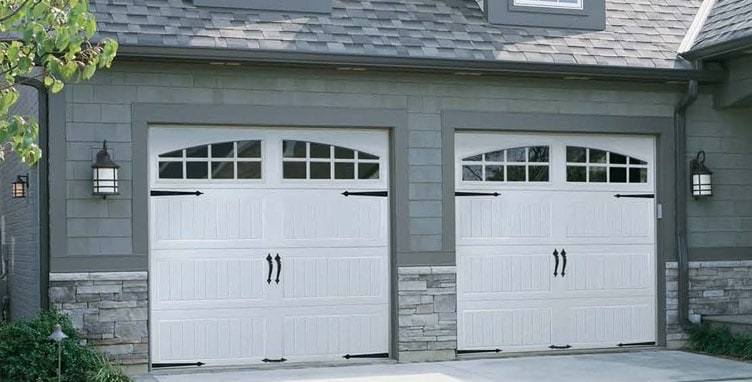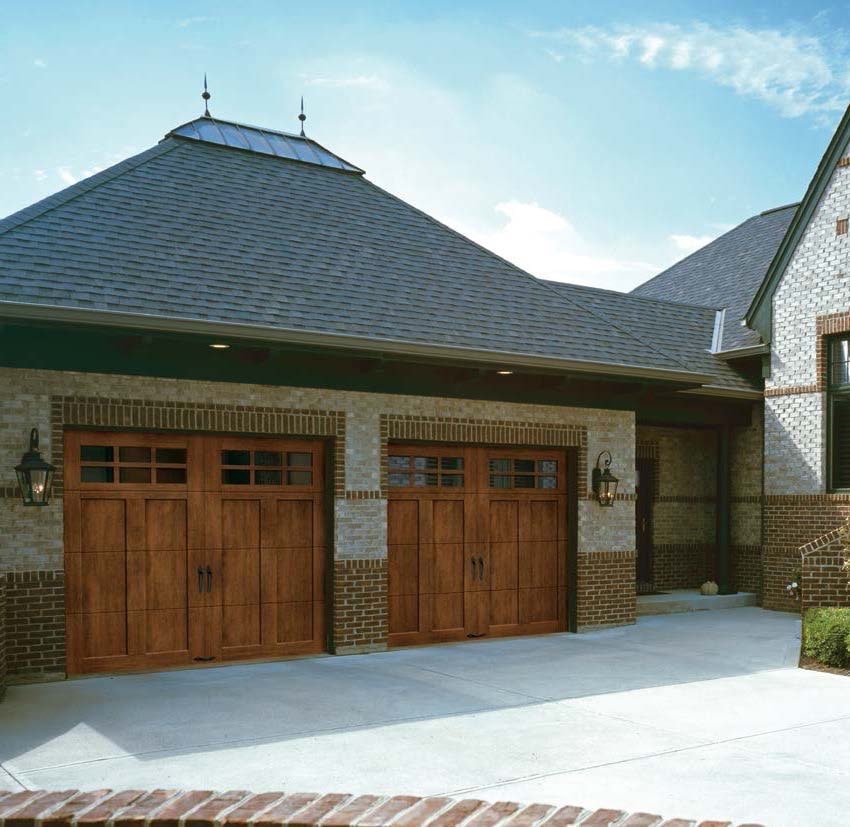Garage Door Options

Make Your Choice Easier
Buying a Garage Door
 Buying a garage door can be one of the more important purchases you make to affect the look and appeal of your home, and we’re here to make your choice easier. In addition to being a big part of your home’s curb appeal, it also provides security and protection from the elements, from a simple vehicle shelter to a heated workspace. There are literally hundreds of styles to choose from, and there are dozens of opening options as well, some even giving the appearance of vintage swinging doors. With all the options, here’s a simple guide to narrowing your choices, and making it easier to choose the right garage door.
Buying a garage door can be one of the more important purchases you make to affect the look and appeal of your home, and we’re here to make your choice easier. In addition to being a big part of your home’s curb appeal, it also provides security and protection from the elements, from a simple vehicle shelter to a heated workspace. There are literally hundreds of styles to choose from, and there are dozens of opening options as well, some even giving the appearance of vintage swinging doors. With all the options, here’s a simple guide to narrowing your choices, and making it easier to choose the right garage door.
Garage Door Sizes and Styles
The size and style of your door will depend on:
- The style and design of your home
Your home’s architectural style should be carried though to the garage door, especially if the garage is visible from the road. - The ways you plan to use your garage
Whether you’re only parking in your garage, using it for serious storage, or using it as a regular workspace in both summer and winter, the style and insulation of your garage door makes a big difference. - The size of your garage
Garages can be built for one, two, or more vehicles, with a garage door for each stall, a large door for multiple stalls, or some combination of the two. - Whether your garage is attached to the house
If the area is detached from the house and used only for storage of your vehicles and tools, then a simple, attractive door will work. If the garage is attached to the house or underneath occupied rooms, or if it is used for a workspace or hobbies, then you’ll want a well-sealed and -insulated door.
Garage Door Options
Should you get an extra strong material? Insulate? Include glass or windows? How do you decide?
Glass in the garage door adds some great natural light, but could be a safety concern if your garage is along the street and easily accessible. Glass will also add to the cost, so you’ll have to decide if security is a concern, and how much natural light (if any) you need.
Since we don’t generally experience very high winds in our area, reinforced garage doors are not often recommended. If you live in an exposed area with regular high winds, and your door is larger than a standard one-vehicle opening, you may want to invest in a reinforced door with stronger materials and heavier track hardware.
While JAY-K Lumber does not perform garage door installations, we will work with you or your contractor to include all the hardware you’ll need. We can also recommend installers in the area if you don’t already have one.
Garage Door Openers
Garage door openers come in options with different power drive levels and power trains, options like lighting, advanced remote options, and more. Stop in to see what’s available. If you plan to purchase a garage door opener, we carry a great selection of America’s best brand, Chamberlain. We’ll make sure your opener is properly rated for your garage door size and weight, and get you everything you need for installation.
 Garage Door Designs
Garage Door Designs
The panel design will create the style of your door, from traditional to carriage to contemporary.
- Carriage House Panels may contain several layers of material that appear, when closed, as
a solid swing door. Carriage style doors are often made of wood or give the appearance of wood. - Flush Panels may be flat or textured, and are generally used for modern designs.
- Raised Panels offer depth to the door and are considered “traditional”—they give the appearance of separate panels without the old wood construction.
- Glass Panels add natural light and come in a variety of styles, even frosted or art glass. Glass panels will increase the cost of your door, and impact the security of your garage space.
Another option is panel “skins”, coatings made in a variety of materials, thicknesses, and layers. Exterior skins may be made of one type of material, with interior skins from a different material, or one of lesser thickness.
- Single layer construction consists of an outer skin of panels with or without glass. This style has little to no insulating value.
- Double layer construction includes the outer skin with an inner layer of polystyrene or polyurethane insulation. The R-value is much better with the insulation included.
- Triple layer construction includes two skins, with the inner polystyrene or polyurethane sandwiched between the skins. This construction provides the highest R-value (the best insulation).
 The frame holding the panels may be built from a variety of materials, or integrated into the construction. The frame may be insulated. Joints may be tongue-and-groove or shiplap to slow airflow or temperature transfer when the door is closed. Weather seals may be used between the sections, and a bottom seal should be installed if it doesn’t come with the door. This stops drafts, can reduce water infiltration, and will deter pests.
The frame holding the panels may be built from a variety of materials, or integrated into the construction. The frame may be insulated. Joints may be tongue-and-groove or shiplap to slow airflow or temperature transfer when the door is closed. Weather seals may be used between the sections, and a bottom seal should be installed if it doesn’t come with the door. This stops drafts, can reduce water infiltration, and will deter pests.
Garage Door Materials
Wood garage door panels give you a unique natural beauty. They can be made from a variety of species—Redwood, Cedar, Fir, Hemlock, and more—in a large selection of designs and layers, including multi-layers with insulation. Wood doors can be stained or painted, and will need regular refinishing and maintenance over the years, so keep in mind that this attractive (and more expensive) option will also require an investment of your time. R-values change with the thickness of the wood panels and the insulation.
Composite Wood garage doors are created from wood fibers and resins to make a wood-grained design that is stable and needs little or no maintenance. When stained or painted, it may be nearly indistinguishable from solid wood. R-values depend on the insulation used between the composite layers.
Fiberglass garage doors can look like wood with graining and coloring. Available in several layers, with insulation that can increase the R-value of the door, fiberglass won’t require maintenance and won’t warp, twist, or expand and contract with moisture and humidity changes. Fiberglass is a great choice for double- or triple-layer construction. R-values depend on the type and amount of insulation.
 Steel garage doors are made in a variety of thicknesses, with or without insulation. Steel is one of the most popular garage door materials. A steel outer skin with insulation may have an inner skin of another material to reduce the cost. Steel doors come in a wide variety of colors, styles, R-values, and prices.
Steel garage doors are made in a variety of thicknesses, with or without insulation. Steel is one of the most popular garage door materials. A steel outer skin with insulation may have an inner skin of another material to reduce the cost. Steel doors come in a wide variety of colors, styles, R-values, and prices.
 Aluminum garage doors are rust- and corrosion-resistant, and can be painted or powder-coated in a huge range of colors. The aluminum panels can be flat or wood-grained. R-values are based on the thickness of the aluminum and the thickness of the insulation.
Aluminum garage doors are rust- and corrosion-resistant, and can be painted or powder-coated in a huge range of colors. The aluminum panels can be flat or wood-grained. R-values are based on the thickness of the aluminum and the thickness of the insulation.
Vinyl garage doors are built in several layers (with or without insulation) to keep the cost down. Vinyl will resist dings and won’t show scratches, since the color is infused throughout the material. It also won’t rot or fall prey to insects, and is virtually maintenance-free. R-values depend on the type and thickness of the insulating layer.

Cost Considerations
The biggest cost factors are the size and material of your door, as well as insulation, and options like glass and skin choices.
The physical size of the door is a major cost factor, and two single doors will cost more than one double door. Let us know the size you need, and we can show you the costs for different materials and styles.
The material used for the skins will be a major part of the budget:
- Wood is expensive, depending upon the species. You’ll need to maintain it on a regular basis; that should be factored into your cost over time.
- Composite Wood costs less than solid wood and more than the least expensive steel, and won’t need maintenance.
- Steel doors with top-of-the-line insulation may cost as much as wood, but lower-quality steel with lower R-values will be more affordable.
- Fiberglass may cost as much as wood (depending upon the amount of insulation), but will not require maintenance over the years.
- Aluminum is in the mid-range of pricing.
- Vinyl is in the lower- to mid-range of cost, and will need little-to-no maintenance.
- Glass will add to the cost of any door. The more decorative, the higher the cost.
 Adding insulation to any door will raise the price, but will also increase your energy savings. The best approach is to get the right insulation for how you plan to use your garage, as we don’t recommend saving money to sacrifice the type of garage you need!
Adding insulation to any door will raise the price, but will also increase your energy savings. The best approach is to get the right insulation for how you plan to use your garage, as we don’t recommend saving money to sacrifice the type of garage you need!
You can combine materials to reduce the cost; say, by purchasing an expensive exterior skin, but a lower-cost interior skin. Ask us about your options.
Installation hardware and labor are also considerations. We can price out installation hardware for you. As mentioned earlier, ask our advice about DIY installation, or recommended contractors for installation.
Get the Garage You Want and Need
When you’re getting started, take some measurements and pictures of your current garage, then stop in to our Door Department for free expert advice.
Explore more of our Tips & Ideas
